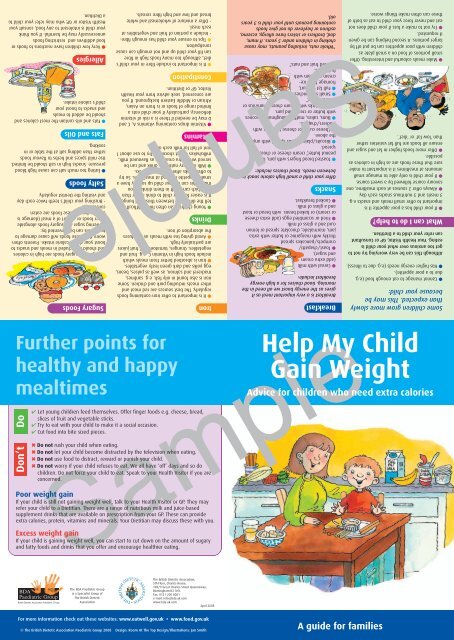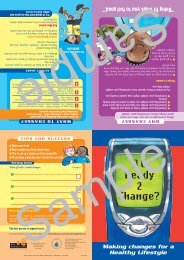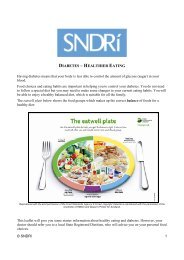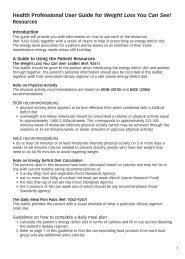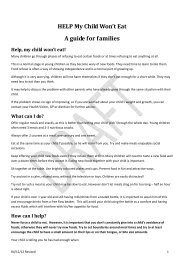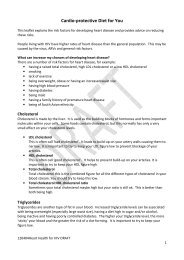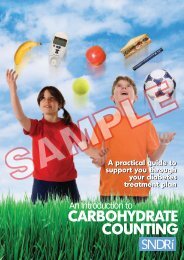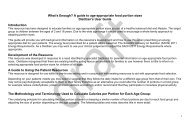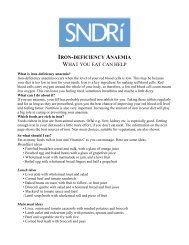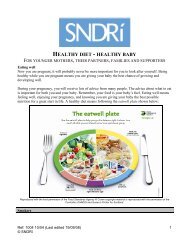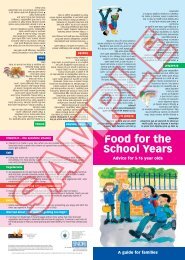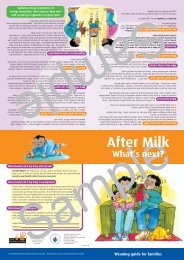Food for the School Years - NDR-UK
Food for the School Years - NDR-UK
Food for the School Years - NDR-UK
Create successful ePaper yourself
Turn your PDF publications into a flip-book with our unique Google optimized e-Paper software.
● Very few children have reactions to foods orfood additives and restricting foodsunnecessarily may be harmful. If you thinkyour child is intolerant to any food, consult yourHealth Visitor or GP, who may refer your child toa Dietitian.● Fats and oils contain <strong>the</strong> most calories andshould be added to mealsand snacks to boost yourchild’s calorie intake.● Eating too much salt can cause high bloodpressure. Snacks high in salt should be limited.Use mild spices and herbs to flavour foodsra<strong>the</strong>r than adding salt at <strong>the</strong> table or incooking.● Sugar and sugary foods are high in caloriesand should be included in meals and snacks toboost your child’s calorie intake. Parents oftenworry that <strong>the</strong>se foods will cause damage toteeth. This can be prevented by:- Offering sugar and sugary foods alongsideo<strong>the</strong>r foods or as part of a meal (damage isusually done if <strong>the</strong>se foods are eatenconstantly).- Brushing your child’s teeth twice each dayand visiting <strong>the</strong> Dentist regularly.Fur<strong>the</strong>r points <strong>for</strong>healthy and happymealtimesDoDon’tSampleAllergiesFats and OilsSalty foodsSugary <strong>Food</strong>s● It is important to include fibre in your child’sdiet, although too many foods high in fibrecan fill your child up and not enough can causeconstipation.● Tips to ensure your child has enough fibre:- Include a portion of fruit and vegetables ateach meal.- Offer a mixture of wholemeal and whitebread and low and high fibre cereals.Constipation● Vitamin drops containing vitamins A, C andD may be needed if <strong>the</strong>re is a risk of vitamindeficiency, particularly if your child eats alimited range of foods or is from an Asian,African or Middle Eastern background. If youare concerned, seek advice from your HealthVisitor, GP or Dietitian.Vitamins● Young children can often find it difficult totell <strong>the</strong> difference between thirst and hunger.It is easier <strong>for</strong> your child to drink ra<strong>the</strong>r thaneat which can result in <strong>the</strong>m drinking toomuch. This can fill your child up so <strong>the</strong>y have asmaller appetite <strong>for</strong> food at mealtimes. So tryto offer drinks after meals and snacks.● Milk is a very nutritious drink and can beserved with extra cream, or as flavoured milk,milkshakes or hot chocolate. Try to use about 1pint of full fat milk each day.Drinks● It is important to offer iron-containing foodsregularly. The best sources are red meat ando<strong>the</strong>r meats including pork and chicken. Someiron is also found in oily fish, e.g. sardines,mackerel and salmon, as well as pulses, beans,egg yolks and dark green leafy vegetables.● Iron is absorbed better from meals whichinclude foods high in Vitamin C, e.g. fruit andvegetables. Oranges, tomatoes and fruit juicesare particularly high.● Avoid giving tea with meals as it reduces<strong>the</strong> absorption of iron.✔ Let young children feed <strong>the</strong>mselves. Offer finger foods e.g. cheese, bread,slices of fruit and vegetable sticks.✔ Try to eat with your child to make it a social occasion.✔ Cut food into bite sized pieces.Iron✖ Do not rush your child when eating.✖ Do not let your child become distracted by <strong>the</strong> television when eating.✖ Do not use food to distract, reward or punish your child.✖ Do not worry if your child refuses to eat. We all have ‘off’ days and so dochildren. Do not <strong>for</strong>ce your child to eat. Speak to your Health Visitor if you areconcerned.*Whole nuts, including peanuts, may causechoking in children under 5 years. If mum,dad, bro<strong>the</strong>rs or sisters have allergy, eczema,asthma or hayfever do not give foodscontaining peanuts until your child is 3 yearsold.● Toasted bread fingers with jam, honey,peanut butter*, cream cheese or chocolatespread.● Biscuits/plain biscuits spread with any of<strong>the</strong> above.● Cheese cubes or cheese triangles withcrackers/chapatti.● Buns, cakes, muffins, doughnuts or sconeswith butter or cream and jam.● Breadsticks with cream cheese, hummus orpeanut butter*.● Small sandwiches.● Full fat yoghurt,fromage frais, icecreamor cream withfruit slices.● Dried fruit and nuts*.Offer your child a small high calorie snack inbetween meals. Good choices include:Snacks● Cereal with milk(add extra creamand sugar).● Toast/chapatti/crumpets/pancakes spreadthickly with margarine or butter with extrajam, marmalade, chocolate spread or lemoncurd and a glass of milk.● Fried or scrambled eggs (add extra cheeseor cream) or baked beans with bread or toastand a glass of milk.● Cooked breakfast.Breakfast is a very important meal as itgives us <strong>the</strong> energy boost we all need in <strong>the</strong>morning. Good choices <strong>for</strong> a high energybreakfast include:BreakfastSamplePoor weight gainIf your child is still not gaining weight well, talk to your Health Visitor or GP. They mayrefer your child to a Dietitian. There are a range of nutritious milk and juice-basedsupplement drinks that are available on prescription from your GP. These can provideextra calories, protein, vitamins and minerals. Your Dietitian may discuss <strong>the</strong>se with you.Excess weight gainIf your child is gaining weight well, you can start to cut down on <strong>the</strong> amount of sugaryand fatty foods and drinks that you offer and encourage healthier eating.● Make meals colourful and interesting. Offersmall portions of food on a small plate aschildren with poor appetites can be put off bylarger portions. A second helping can be givenif requested.● Try not to make a fuss if your child does noteat and never <strong>for</strong>ce your child to eat as both of<strong>the</strong>se can often make things worse.● If your child has a poor appetite it isimportant to offer small meals and snacks e.g.3 meals and 3 nutritious snacks each day.● Always offer 2 courses at each mealtime, onesavoury course followed by a sweet course.● If your child is only able to manage smallamounts at mealtimes it is important to makesure that <strong>the</strong>se foods are as high in calories aspossible.● Offer more foods higher in fat and sugar andensure all foods are full fat varieties ra<strong>the</strong>rthan ‘low fat’ or ‘diet’.What can I do to help?Although this can be very worrying try not toget too anxious over what your child iseating. Your Health Visitor, GP or Consultantcan refer your child to a Dietitian.● Cannot manage to eat enough food (e.g.due to a poor appetite).● Has higher energy needs (e.g. due to illness).Some children grow more slowlythan expected. This may bebecause your child:Help My ChildGain WeightAdvice <strong>for</strong> children who need extra caloriesThe BDA Paediatric Groupis a Specialist Group ofThe British DieteticAssociationThe British Dietetic Association,5th Floor, Charles House,148/9 Great Charles Street Queensway,Birmingham B3 3HT.Fax: 0121 200 8081e-mail: info@bda.uk.comwww.bda.uk.comApril 2008For more in<strong>for</strong>mation check out <strong>the</strong>se websites: www.eatwell.gov.uk • www.food.gov.uk© The British Dietetic Association Paediatric Group 2008 Design: Room At The Top Design/Illustrations: Jan SmithA guide <strong>for</strong> families
<strong>Food</strong> GroupsFruit and vegetablesAlways try to offer fruit andvegetables with <strong>the</strong> majority of mealsand snacks. Fruit and vegetables giveyou Vitamins A and C, fibre and someare good sources of iron. Generallyfruit and vegetables do not containmany calories and can be quite filling,<strong>the</strong>re<strong>for</strong>e always try to offer highcalorie foods at <strong>the</strong> same time.Calorie boosting tips:● Margarine or butter can be meltedover vegetables. Vegetables can also beroasted in oil as an alternative to boiling.● Try grating or melting full fat cheeseover vegetables.● Serve a cheese sauce (made withfull fat milk and full fat cheese) withvegetables e.g. cauliflower cheese orbroccoli bake.● Sticks of raw vegetables can beserved with a dip or hummus.Salad oils or dressings can beadded over salad vegetables.● Add vegetables to soups.Double cream can <strong>the</strong>n beadded to increase <strong>the</strong> caloriecontent.Eating a combination of foods from each food group will give your child all <strong>the</strong> nutrients <strong>the</strong>y need,but extra calories are needed from foods which are higher in fat and sugar.● Vegetables can be added to pizza butmake sure extra cheese is added on topas well.● Try to serve fruit with ano<strong>the</strong>r highcalorie food e.g. bananas and cream orfromage frais, stewed fruit with full fatcustard or evaporated milk, apple crumblewith custard or ice-cream, fruit dipped inchocolate e.g. chocolate coatedstrawberries.● Avoid overcooking vegetables becausethis can destroy some of <strong>the</strong> nutrients.Don’t soak vegetables in water, as someof <strong>the</strong> nutrients such as vitamin C will beleft behind in <strong>the</strong> water.Bread, o<strong>the</strong>r cereals and potatoesServe <strong>the</strong>se foods with all meals.These foods include breakfast cereals,bread, chapatti, pasta, rice, couscous,millet, potatoes, yam and greenbanana. <strong>Food</strong>s made with flour e.g.pizza bases, buns and pancakes arealso included in this group.These foods will give your child plentyof starchy carbohydrates needed <strong>for</strong>energy. They also provide B vitamins,fibre and some iron and zinc.Calorie boosting tips:● Encourage vitamin and iron enrichedbreakfast cereals e.g. Cornflakes, Rice-Krispies, Shreddies, Weetabix. Serve withfull fat milk (extra cream can be added tomilk to increase <strong>the</strong> calorie content).● Spread butter or margarine thickly ontobread, hot toast, chapatti, pitta bread,plain biscuits, crackers, fruit loaf, bagelsor crumpets.● As well as spreading <strong>the</strong>se with butteror margarine - spread with jam,marmalade, chocolate spread, lemon curdor cheese spread to give even morecalories.● Butter or cheese can be melted overpasta and served with meat, tomato or acheese sauce.● Extra butter, cream or cheese canbe added into potatoes or yam.● Try having potatoes that areroasted or chipped. Left overpotatoes can be fried.SampleMeat, fish, eggs,dahl, pulses and nutsOffer your child foods from this group atleast twice a day. These foods provideprotein to help your child to grow. Theyalso provide iron, zinc, B vitamins andvitamin A. Some also provide good sourcesof omega 3 fats.Calorie boosting tips:● Avoid using lean meats and cutting offvisible fat be<strong>for</strong>e cooking to help maximise <strong>the</strong>energy content. Chicken and turkey skin has alot of fat so leave <strong>the</strong> skin on when cooking.● Try to fry meat dishes ra<strong>the</strong>r than grilling orbaking e.g. sausages, beef burgers, fish fingers● Tuna (preferably in oil), cold meat, pastes,pates, mashed sardines, hummus or peanutbutter* make great sandwich fillers or use ontoast that has been spread with butter ormayonnaise.● Fish is quick and easy to cook – fish in batterwill provide more calories. Fry fish fingers orserve fish in a white sauce.● Eggs can be fried or scrambled (with extracream added). Omelettes or eggy bread aredifferent ways to serve eggs and are also fried!(Extra cheese and cream can also be added to<strong>the</strong>se).● Many children prefer meat to be soft &moist. Shepherd’s pie, meatballs, spaghettibolognaise or lasagne are popular. Be sure tomelt extra cheese on top.*See notes about nuts on page 2<strong>Food</strong>s high in fat and sugarThese foods will provide <strong>the</strong> best source of calories, although <strong>the</strong>yhave fewer nutrients. When using fats and oils, choose ones with ahigh content of omega 3 fats, <strong>for</strong> example olive oil, walnut oil andrapeseed oil.<strong>Food</strong>s in this group include cream, butter, margarine, cooking andsalad oils, mayonnaise, chocolate, crisps, sweets, biscuits, cake,ice-cream, pies, pastries, fizzy drinks, jam, syrup and sugar.Calorie boosting tips:● Spread butter or margarine thickly on bread, hot toast, crumpetsand pancakes.● Spread butter, margarine, chocolate spread or peanut butter* ontoplain biscuits such as crackers.● Cream can be added to full fat milk to make an extra creamy drinkor poured over breakfast cereals, used in porridge or instant oatcereal.● Cream can also be stirred into puddings e.g. custard, rice puddingor yoghurts, or whipped and added to hot chocolate drinks.● Always offer a pudding after a meal e.g. chocolate cake, biscuits,jelly and ice cream, fruit pies or crumbles.● Try to add extra sugar to drinks, puddings and sprinkle over cereals.● Encourage pastry foods e.g. apple pies, sausage rolls, steak pie andquiches.● Instead of grilling, baking or steaming foods - fry <strong>the</strong>m in oil ormargarine to increase <strong>the</strong> calorie content e.g. fry sausages, burgers,fish fingers and eggs. If possible fry chips ra<strong>the</strong>r than using ovenchips.Milk anddairy foodsOffer your child three servings of milk, yoghurtor cheese each day.As well as giving your child extra calories<strong>the</strong>se foods provide protein, calcium, Bvitamins and iodine.Calorie boosting tips:● Milk is a very nutritious drink. Use full fat milkra<strong>the</strong>r than semi-skimmed or skimmed milk asthis contains more calories.● Adding cream into full fat milk will provideeven more calories. You can add ice-cream to aglass of full fat milk to make a milk shake.● Choose full fat yoghurts, yoghurt drinks,fromage frais, and thick and creamy varieties, orready to eat desserts, as a pudding or snackbetween meals. Extra cream can also be added to<strong>the</strong>se.● Cheese is very high in calories and verynutritious. Try grating cheese into scrambled eggs,mashed or baked potatoes, pasta and savouryflans or use it in a white sauce to make macaronicheese, cauliflower cheese or broccoli bake. Softcheese can also be added to some of <strong>the</strong>se foods.● Grated cheese, cheese spreads or cheeseportions can be used as sandwich fillers, on toastor as a snack. Cheese can be added ontohamburgers or extra cheese added on top ofpizzas.● Avoid cheese which is labelled low fat orcottage cheese, as <strong>the</strong>se are lower in calories.● Use paneer in curries or serve a curry with fullfat yoghurt.Sample


